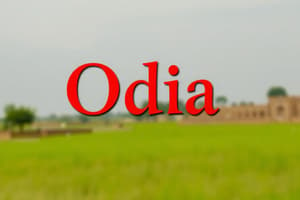Podcast
Questions and Answers
What is the writing system of the Odia language based on?
What is the writing system of the Odia language based on?
- Arabic script
- Cyrillic script
- Brahmi script (correct)
- Latin script
Which sentence structure is primarily used in the Odia language?
Which sentence structure is primarily used in the Odia language?
- Verb-Subject-Object (VSO)
- Object-Subject-Verb (OSV)
- Subject-Object-Verb (SOV) (correct)
- Subject-Verb-Object (SVO)
What is the approximate number of speakers of the Odia language?
What is the approximate number of speakers of the Odia language?
- 25 million
- 10 million
- 60 million
- 40 million (correct)
Which of the following is NOT a major dialect of Odia?
Which of the following is NOT a major dialect of Odia?
Which notable author contributed to modern Odia literature?
Which notable author contributed to modern Odia literature?
Flashcards are hidden until you start studying
Study Notes
Overview of Odia Language
- Language Family: Indo-Aryan, part of the larger Indo-European family.
- Region: Primarily spoken in the Indian state of Odisha and neighboring areas.
- Speakers: Approximately 40 million speakers.
Script
- Writing System: Odia script, derived from the Brahmi script.
- Characteristics:
- Abugida system (each character represents a consonant with an inherent vowel).
- Distinct circular shapes and loops.
Dialects
- Major Dialects:
- Standard Odia (used in media and education).
- Sambalpuri, Baleswari, and other regional variants.
Grammar
- Sentence Structure: Subject-Object-Verb (SOV) order.
- Tenses: Present, past, and future forms.
- Nouns: Gendered (masculine, feminine, neuter).
- Pronouns: Distinct forms for formal and informal contexts.
Vocabulary
- Loanwords: Influenced by languages like Sanskrit, Bengali, and Hindi.
- Common Roots: Many words are derived from Sanskrit.
Literature
- Historical Texts: Ancient scriptures, poetry, and prose dating back to the 10th century.
- Modern Literature: Flourished in the 19th and 20th centuries; notable authors include Fakir Mohan Senapati and Kuntala Kumari Sabat.
Cultural Significance
- Cultural Identity: Integral to Odia identity and heritage.
- Festivals: Language plays a key role in cultural festivities and traditions, such as Raja and Nuakhai.
Language Status
- Official Status: Recognized as an official language in Odisha.
- Language Promotion: Government and cultural organizations promote Odia through education, literature, and media.
Preservation Efforts
- Initiatives: Programs aimed at preserving and promoting the language among younger generations.
- Digital Presence: Increasing use of Odia in digital platforms, social media, and online content.
Overview of Odia Language
- Language family classified under Indo-Aryan, which is a branch of the Indo-European family.
- Predominantly spoken in the Indian state of Odisha, as well as surrounding regions.
- Approximately 40 million native speakers.
Script
- Utilizes the Odia script, which has its origins in the ancient Brahmi script.
- Features an abugida writing system, where each character represents a consonant combined with an inherent vowel.
- Notable for its unique circular shapes and loops characteristic of the script.
Dialects
- Major dialects include Standard Odia, which is commonly used in media and educational settings.
- Other regional dialects like Sambalpuri and Baleswari reflect local linguistic variations.
Grammar
- Follows a Subject-Object-Verb (SOV) sentence structure.
- Tenses are categorized into present, past, and future forms.
- Nouns are gendered into masculine, feminine, and neuter categories.
- Pronouns exhibit distinct forms for formal and informal usage.
Vocabulary
- The language contains loanwords influenced by Sanskrit, Bengali, and Hindi.
- Many common words have roots traceable to Sanskrit, showcasing cultural and historical connections.
Literature
- Has a rich literary heritage with ancient texts, poetry, and prose dating back to the 10th century.
- Modern literary contributions surged during the 19th and 20th centuries, with notable figures such as Fakir Mohan Senapati and Kuntala Kumari Sabat.
Cultural Significance
- Holds a vital role in forming Odia cultural identity and heritage.
- Language is central to various festivals and cultural celebrations, including Raja and Nuakhai.
Language Status
- Officially recognized as an official language within the state of Odisha.
- Supported by government and cultural organizations that promote Odia in education, literature, and media channels.
Preservation Efforts
- Ongoing initiatives aimed at preserving Odia and enhancing its relevance among younger generations.
- Increasing presence on digital platforms, social media, and online content contributes to the language's resilience.
Studying That Suits You
Use AI to generate personalized quizzes and flashcards to suit your learning preferences.




